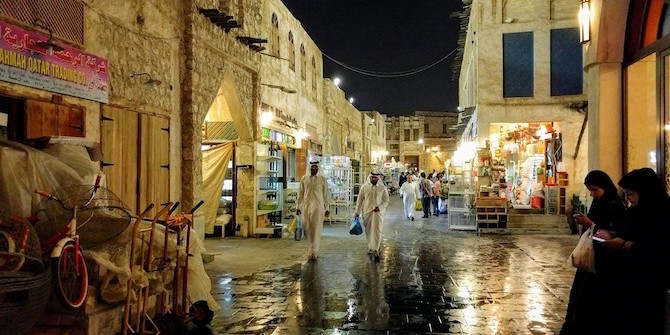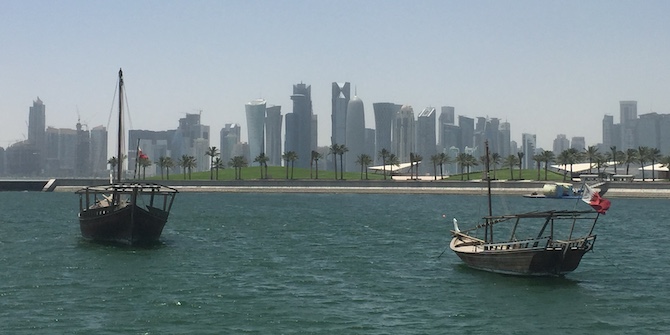by İdil Akıncı

The role of museums in nation-building processes is especially intriguing in the context of the Gulf States, given that not only are these countries less than five decades old, but also a significant portion of their citizenries originate from outside the Arabian Peninsula. The region’s cosmopolitan past and its inhabitants’ links to, and origins from, various parts of the Indian Ocean, Yemen, Baluchistan, Southern Persia, and Africa were developed as a result of links forged through colonialism, trade and slavery. While the legacies of this past are very much reflected on the societal organisation of these national communities, especially in port cities such as Dubai and Doha, Gulf national identities are officially and popularly narrated as being Arab, Bedouin and tribal. The question then becomes how tribal, ethnic, cultural and racial diversities among the citizens of the Gulf States are represented in national museums today?
Responding to the proliferation of museums in the region, which ‘act as supports for an invented national story’, there is a body of literature which investigates the role of museums and use of archaeology, objects, images and stories in downplaying the social divisions among citizenry and enhancing official versions of national identity among Gulf citizens. Some of these works illustrate how pre-nation inhabitants of the region, some of whom become citizens, including Persians, Africans and Indians, have been elided and represented as Arabs in these museums and heritage villages, while others focus on the tensions of representational balance between Bedouin and urban segments of society in the national museums. While such literature enlightens us about the processes of state-sponsored production of national identity in the Gulf, it does not show how these projects are articulated by the people at whom they are aimed.
In line with the existing literature, papers presented at the LSE Middle East Centre’s ‘Heritage and National Identity Construction in the Gulf’ workshop underlined the central role Gulf states play in curating museum displays, especially with regards to national identity. Some of the papers attributed the dominance of state led initiatives in national identity formation to the ‘conservative’ nature of the Gulf states. While state-led projects are integral to the ways in which national identities are represented in Gulf museums, they are not immutable and can offer a complex and at times contradictory displays in the way nation is presented. Moreover, the exhibits in museums are open to the imagination of visitors, where they have the capacity to negotiate, (re)define, contest or internalise the ways in which their identities are represented. Ignoring these nuances and complex processes of identity formation in the analysis of Gulf museums is problematic for a variety of reasons.

Firstly, by portraying Gulf museums as unique and exceptional, these accounts downplay how museums worldwide – especially those that deal with contentious issues such as national identity, culture and heritage – are inescapably political. Museum displays represent a selective version of history that is carefully curated by elite segments of the national population. Concealing or downplaying alternative narratives about a nation’s identity in public spaces, such as museums, is essential in the way a society is taught to forget as well as remember who they are ought to be as a nation. Initiatives for decolonising museums in a number of ‘Western’ contexts illustrates that museums are, and always have been, historically sites of unequal representation, where in/exclusion of stories and individuals are contingent on socio-political circumstances. Thus, attributing the centrality of state-led initiatives in nation building to Gulf ‘conservatism’ disconnects the region from the wider literature on museum studies and reproduces existing ‘Gulf exceptionalism’ in the broader study of national identities.
Secondly, Gulf museums that provide an alternative to the popular displays of Gulf identity through ‘coffee pots and camels’ are often not accounted for. One important example of this is the Bin Jelmood Museum in Doha, opened in 2015 by Sheikha Moza Bint Nasser. Bin Jelmood House, once home to a prominent slave owner, charts the history of Indian Ocean slave trade and the social, cultural and economic transformations it brought to Gulf societies. By acknowledging the region’s involvement with the global slave trade and the fact that some Qatari citizens are descendants of both slaves and slave owners, Bin Jelmood House confronts this particularly sensitive issue. Moreover, the museum connects the history of slavery to contemporary times and discusses the conditions of labourers in the Gulf. The opening of the government-funded and foreign-curated Bin Jelmood House came at the height of the global criticism Qatar was receiving in its treatment of migrant labourers working to build stadiums for the 2022 World Cup.
Thirdly, and perhaps most importantly: overemphasising the role of state-led initiatives ignores the ways in which people engage with what is represented in these museums. After all, the success of nation-engineering projects is determined by the way they are internalised, challenged or celebrated by those who visit these museums. In this sense, it is not as important to examine whether, for example, Bin Jelmood House is a political tool employed by the Qatari state to present itself as ‘liberal and self-critical’ in the global arena. The instrumental nature of the museum doesn’t change the fact that it offers visitors an alternative historical account to the popular discourse about the origins of Gulf nationals. Moreover, it is located in the heart of Doha and offers free entry. Important, then, in the study of Gulf national identity formation is analysing how these displays are interpreted by migrants and citizens.
Does openly acknowledging that not all Gulf nationals are of Arab, Bedouin and tribal origins offer a sense of inclusion or othering for nationals and migrants? The short conversation I had with the Qatari guide at the Bin Jelmood Museum, when I visited in 2016, suggest that both Qataris of slave origins and those who owned slaves are not comfortable with the existence of the museum. Purposefully forgetting this past and distancing themselves from any links to Africa is a common strategy among Gulf citizens of slave origins as it works to maintain the salient boundaries that exists between migrants and citizens. While there is little incentive to acknowledge families’ relationships with slavery, other minority Qataris may feel differently. My guide at the museum, a Qatari with origins in Southern Persia, was rather enthusiastic for the opening of ‘A Journey to the Heart of Life’ exhibition at the museum, showcasing the social and cultural diversity among Qatari nationals. He underlined the long trading links of his family to the Gulf and wanted to see this being displayed at the museum. Perhaps the issue of whether this promotes inclusion or othering will differ greatly depending on not only the minority group in question, but also on the individuals within these groups – each situated differently based on their socio-economic and cultural location as well as their specific migration trajectory to the Gulf.
This is part of a series emerging from a workshop on ‘Heritage and National Identity Construction in the Gulf’ held at LSE on 5–6 December 2019. Read the introduction here, and see the other pieces below.
In this series:
- Introduction by Courtney Freer
- Souvenir Sovereignty in Qatar by Suzi Mirgani
- Examining Kuwait National Museum by Sundus Alrashid
- Urban Planning and its Legacy in Kuwait by Alexandra Gomes
- The New Populist Nationalism in Saudi Arabia: Imagined Utopia by Royal Decree by Madawi Al-Rasheed
- Heritage and Sectarianism in Bahrain by Thomas Fibiger
- Dubai Expo 2020 and Ancient Mercantile Heritage by Robert Mogielnicki
- Managing UNESCO World Heritage Sites in Saudi Arabia: Contribution and Future Directions by Abdulelah Al-Tokhais
- Finding Mariam: the Invisible Woman in National Heritage Mythology by Alanoud Al-Sharekh
- Cultural Attendance: Attracting the Crowds to Museums in Saudi Arabia by Maha al-Senan
- Religion and Heritage in the Gulf: Significant in its Absence? by Courtney Freer
- Historical Archaeology in the Gulf by Robert Carter
- Militarised Nationalism in the Gulf Monarchies: Crafting the Heritage of Tomorrow by Eleonora Ardemagni
- The Practice of Heritage in the Northern United Arab Emirates by Matthew MacLean
- Displaying the Nation in Museum Exhibitions in Qatar by Alexandra Bounia
- Implicit and Explicit Cultural Policies in Qatar: Contemporary Art Production and Censorship by Serena Iervolino
- The UAE State ‘Rebirthing’ of Motherhood: Who is birthing who? by Rima Sabban






